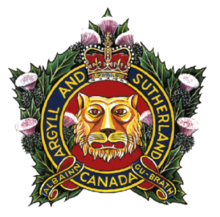Argyll and Sutherland Highlanders of Canada
| The Argyll and Sutherland Highlanders of Canada (Princess Louise's) | |
|---|---|

Cap badge of the Argyll and Sutherland Highlanders of Canada
|
|
| Active | 1903–present |
| Country | Canada |
| Branch | Canadian Army |
| Type | Light Infantry |
| Role | To close with and destroy the enemy |
| Size | 1 battalion |
| Part of | 31 Canadian Brigade Group |
| Garrison/HQ | Hamilton |
| Nickname(s) | The Argylls |
| Motto(s) | Scottish Gaelic: Albainn gu brath (Scotland forever) |
| March | Quick: "The Campbells Are Coming" |
| Engagements |
Somme 1916 Vimy 1917 Passchendaele Ypres 1917 Falaise The Scheldt |
| Website | army-armee |
| Commanders | |
| Colonel-in-chief | HM The Queen |
| Insignia | |
| Tartan | Sutherland |
The Argyll and Sutherland Highlanders of Canada (Princess Louise's), or A & SH of C, is a Primary Reserve Highland infantry regiment of the Canadian Forces, based at John W. Foote VC Armoury in Hamilton, Ontario.
The idea for a full Highland regiment in Hamilton first took shape among the members of the St. Andrew's Society (of which James Chisholm was the long-time treasurer) and the Sons of Scotland (of which, he was also a member). Late in 1902 meetings were held and prominent members of the city's Highland-Canadian community were asked to "take hold of the matter."
James Chisholm and his partner, William Logie (a captain in the XIII Regiment), took a leading role in organizing locally and in lobbying Ottawa. With the support of local Scottish organizations and clan societies, a deputation was sent to Ottawa bearing a petition to the minister of Militia. The minister, Frederick Borden, was less than enthusiastic about the potential cost and the Highland character of the proposed unit (he wanted the militia in a common uniform). Col. W. D. Otter, whom Logie canvassed for his opinion, was skeptical of the group's ability to "get either the officers or the men and if we got both [of] these we could not get the money …"
Hamilton's Scottish-Canadian elite moved quickly to fill the ranks of the officer corps and to raise the necessary funds to outfit the regiment in full Highland dress. Those who came forward included: Chisholm, Logie, J. R. Moodie, Walter W. Stewart, E. M. Dalley, Roy Moodie, E. F. Lazier, John Inglis McLaren, and many others from all walks of professional and business life.
A draft letter written by either Chisholm or Logie to local MPs noted that the proposed "officers are a fine lot of fellows and of good standing and large influence in the community." The group obtained (as of 25 March 1903) over 700 names for the rank and file. The "men are a particularly fine class drawn chiefly from the better class of Scotchmen who own their own homes and have a stake in the community." Chisholm and Logie were well-connected within the Liberal Party and maintained steady pressure upon local politicians to forward the group's cause. Chisholm monitored all communications with Borden. When the minister curtly informed a local lawyer to forward his support of the proposed Highland regiment "through the regular official channel," Chisholm promptly asked the minister of Militia for an explanation particularly as Borden had already written to Chisholm indicating that a Highland regiment would be raised. Borden denied having done so but by 17 August 1903 he reported (confidentially to Logie) authorizing the establishment of a Highland regiment. Chisholm, Logie, and the Scottish community were unrelenting and in the end won the day.
...
Wikipedia
